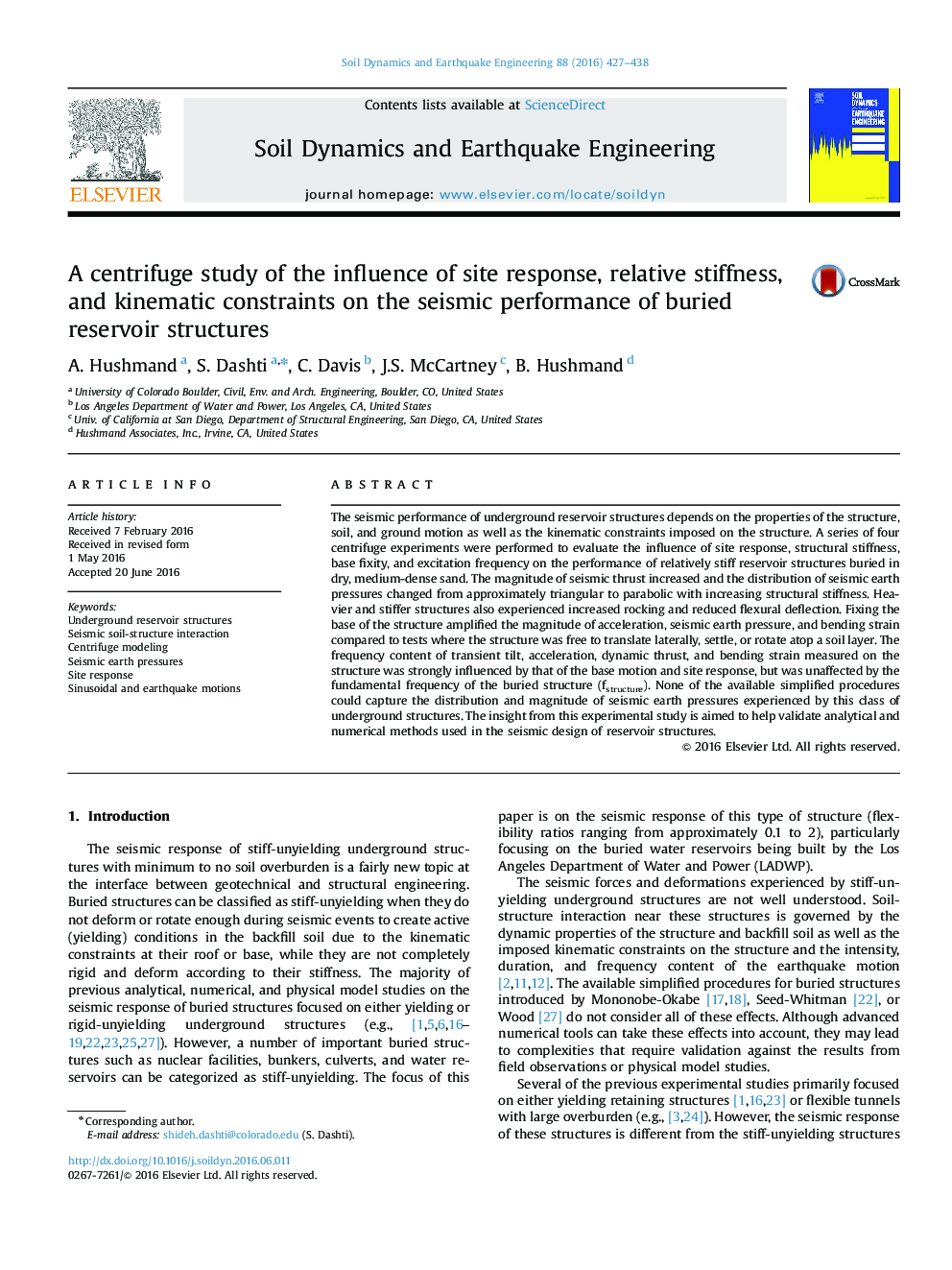| کد مقاله | کد نشریه | سال انتشار | مقاله انگلیسی | نسخه تمام متن |
|---|---|---|---|---|
| 6771337 | 512756 | 2016 | 12 صفحه PDF | دانلود رایگان |
عنوان انگلیسی مقاله ISI
A centrifuge study of the influence of site response, relative stiffness, and kinematic constraints on the seismic performance of buried reservoir structures
ترجمه فارسی عنوان
مطالعه ای سانتریفیوژ در مورد تأثیر پاسخ سایت، سفتی نسبی و محدودیت های حرکتی بر عملکرد لرزهای ساختار مخزن دفن شده
دانلود مقاله + سفارش ترجمه
دانلود مقاله ISI انگلیسی
رایگان برای ایرانیان
کلمات کلیدی
سازه های زیرزمینی مخزن، تعامل لرزه خاک-ساختار مدل سازی سانتریفیوژ، فشار زمینی لرزه ای، پاسخ سایت، حرکات سینوسی و زلزله،
ترجمه چکیده
عملکرد لرزه ای سازه های زیرزمینی مخزن بستگی به خواص ساختار، خاک و حرکت زمین و همچنین محدودیت های حرکتی اعمال شده بر ساختار دارد. یک سری از چهار آزمایش سانتریفیوژ برای ارزیابی تأثیر پاسخ سایت، سختی ساختاری، پایداری پایه و فرکانس تحریک در عملکرد سازه های مخزن نسبتا سفت شده در خاک خشک و متوسط متراکم انجام شد. میزان نیروی لرزه ای افزایش یافته و توزیع فشارهای زمین لرزه ای از تقریبا مثلثی تا پارابولی با افزایش سختی ساختاری تغییر یافته است. ساختارهای سنگین تر و سخت تر نیز موجب افزایش تکان و کاهش انحراف خمشی می شوند. رفع پایه ساختار موجب افزایش شتاب، فشار زمین لرزه ای و فشار خم در مقایسه با آزمایش هایی بود که ساختار آزاد بود برای ترجمه به سمت چپ، حل و فصل و یا چرخش روی یک لایه خاک. مقدار فرکانس شیب موقت، شتاب، راندمان دینامیکی و فشار خمشی اندازه گیری شده بر ساختار به شدت تحت تأثیر حرکت پایه و پاسخ سایت قرار گرفت، اما با فرکانس اساسی ساختار دفن شده (ساختار) تأثیری نداشت. هیچ یک از رویه های ساده موجود نمی تواند توزیع و میزان فشار زمین لرزه ای تجربه شده توسط این طبقه از سازه های زیرزمینی را بدست آورد. بینش این مطالعه تجربی با هدف کمک به اعتبار سنجی روش های تحلیلی و عددی مورد استفاده در طراحی لرزه ای سازه های مخزن است.
موضوعات مرتبط
مهندسی و علوم پایه
علوم زمین و سیارات
مهندسی ژئوتکنیک و زمین شناسی مهندسی
چکیده انگلیسی
The seismic performance of underground reservoir structures depends on the properties of the structure, soil, and ground motion as well as the kinematic constraints imposed on the structure. A series of four centrifuge experiments were performed to evaluate the influence of site response, structural stiffness, base fixity, and excitation frequency on the performance of relatively stiff reservoir structures buried in dry, medium-dense sand. The magnitude of seismic thrust increased and the distribution of seismic earth pressures changed from approximately triangular to parabolic with increasing structural stiffness. Heavier and stiffer structures also experienced increased rocking and reduced flexural deflection. Fixing the base of the structure amplified the magnitude of acceleration, seismic earth pressure, and bending strain compared to tests where the structure was free to translate laterally, settle, or rotate atop a soil layer. The frequency content of transient tilt, acceleration, dynamic thrust, and bending strain measured on the structure was strongly influenced by that of the base motion and site response, but was unaffected by the fundamental frequency of the buried structure (fstructure). None of the available simplified procedures could capture the distribution and magnitude of seismic earth pressures experienced by this class of underground structures. The insight from this experimental study is aimed to help validate analytical and numerical methods used in the seismic design of reservoir structures.
ناشر
Database: Elsevier - ScienceDirect (ساینس دایرکت)
Journal: Soil Dynamics and Earthquake Engineering - Volume 88, September 2016, Pages 427-438
Journal: Soil Dynamics and Earthquake Engineering - Volume 88, September 2016, Pages 427-438
نویسندگان
A. Hushmand, S. Dashti, C. Davis, J.S. McCartney, B. Hushmand,
